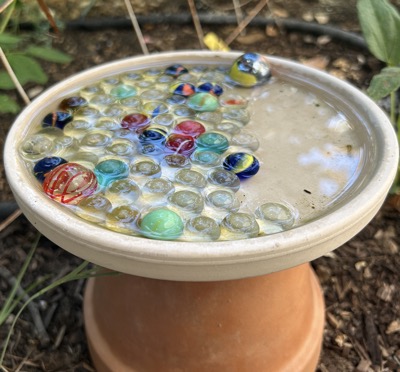
Water trays benefit these beneficial insects in more ways than one

A honey bee pauses for a bit of nectar as well as pollen from a coneflower. Honey bees search for water to cool the hive when temperatures get above 96.8 degrees. Kathy Morrison
People and pets aren’t the only ones who need ways to stay cool during triple-digit heat; bees could use some help, too.
Honey bees in particular benefit from water trays – shallow dishes of water with pebbles or marbles or corks – when temperatures go above 100 degrees. (The pebbles give bees a place to land so they don’t drown.) Honey bees are using that water not just to drink but to cool off their hives.
According to research from Oregon State University, honeybees use water – and wings – to create their own version of A.C.

“Honey bees are somewhat adapted to extreme heat,” report OSU researchers. “As soon as temperatures in a honey bee colony edge up beyond 96.8 degrees F., worker bees line up at the entrance and start fanning their wings. In addition, a special group of water-foraging bees begins scouring the surrounding area for water, which they collect and bring back to the nest.
“The bees distribute droplets of water around the nest, which works in parallel with the fanning to create the equivalent of honey bee A.C., or air conditioning. As temperatures rise to extreme heat levels, more honey bees will start to forage for water.”
Bumblebees tend to suffer most from the heat; they have trouble flying when it’s over 100 degrees, say the researchers. Bumblebees have been seen foraging for water (and may visit available water trays), but it’s not certain if they use the honey bee A.C. method to cool their nests.
Other bees don’t make as much use of the water trays, says OSU, but have other ways of coping. Ground-dwelling bees – which include many native bees – avoid the heat by staying under the cool soil.
One thing is certain: Most bee activity drops dramatically in triple-digit temperatures. Instead, they’ll forage (and pollinate) in the very early morning hours after dawn or just before twilight. Expect spotty pollination of squash and melons until weather cools back to normal.
How much longer will this current heat wave persist? According to the National Weather Service, Sacramento can expect afternoon highs over 100 through at least Thursday, July 11. That would match Sacramento’s all-time record of most consecutive triple-digit days – 11 – set in July 2009.
For more on bees and heat: https://extension.oregonstate.edu/gardening/pollinators/how-help-bees-survive-heat-wave.
For weather updates: https://www.weather.gov/sto/#.
Comments
0 comments have been posted.Sacramento Digs Gardening to your inbox.
Sites We Like
Garden Checklist for week of Oct. 27
It's still great weather for gardening. Grab a sweater – and an umbrella, just in case – then get to work:
* October is the best month to plant trees, shrubs and perennials.
* Harvest pumpkins and winter squash.
* Pick apples and persimmons. Remember to pick up fallen fruit, too; it attracts pests.
* Clean up the summer vegetable garden and compost disease-free foliage.
* Dig up corms and tubers of gladioli, dahlias and tuberous begonias after the foliage dies. Clean and store in a cool, dry place.
* Treat azaleas, gardenias and camellias with chelated iron if leaves are yellowing between the veins.
* Now is the time to plant seeds for many flowers directly into the garden, including cornflower, nasturtium, nigella, poppy, portulaca, sweet pea and stock.
* Plant seeds for radishes, bok choy, mustard, spinach and peas.
* Plant garlic and onions.
* Set out cool-weather bedding plants, including calendula, pansy, snapdragon, primrose and viola.
* Reseed and feed the lawn. Work on bare spots.